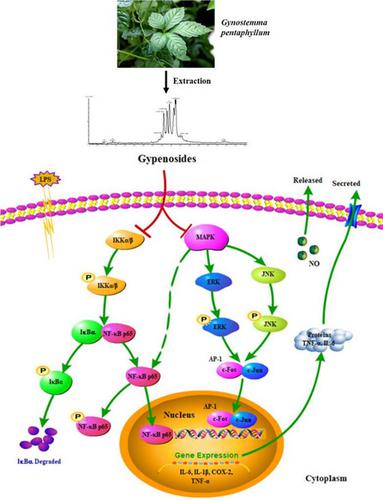当前位置:
X-MOL 学术
›
Food Sci. Nutr.
›
论文详情
Our official English website, www.x-mol.net, welcomes your
feedback! (Note: you will need to create a separate account there.)
Chemical composition of tetraploid Gynostemma pentaphyllum gypenosides and their suppression on inflammatory response by NF‐κB/MAPKs/AP‐1 signaling pathways
Food Science & Nutrition ( IF 3.5 ) Pub Date : 2020-01-14 , DOI: 10.1002/fsn3.1407 Bo Wang 1 , Ming Li 1 , Hang Gao 1 , Xiangjun Sun 1 , Boyan Gao 1 , Yaqiong Zhang 1 , Liangli Yu 2
Food Science & Nutrition ( IF 3.5 ) Pub Date : 2020-01-14 , DOI: 10.1002/fsn3.1407 Bo Wang 1 , Ming Li 1 , Hang Gao 1 , Xiangjun Sun 1 , Boyan Gao 1 , Yaqiong Zhang 1 , Liangli Yu 2
Affiliation

|
The chemical composition and anti‐inflammatory activity of gypenosides isolated from tetraploid Gynostemma pentaphyllum (GP) leaves were investigated. The gypenosides accounted for 7.43 mg/g of the tested GP sample, which were composed of four major saponins including isomers of gypenoside 1 and 2 (C47H76O18), 3 (C47H76O17), and 4 (C46H74O17). Pretreatment of gypenosides reduced mRNA expressions of the proinflammatory mediators in LPS‐stimulated RAW264.7 macrophage cells, such as IL‐6, IL‐1β, COX‐2, and TNF‐α in a dose‐dependent manner. The secreted protein levels of IL‐6 and TNF‐α, and NO production were also decreased by gypenosides within the concentration range of 50–200 μg/ml. Moreover, the mechanism studies demonstrated that gypenosides (200 μg/ml) treatment significantly inhibited the nuclear translocation of nuclear factor‐κB and activator protein 1 (c‐Fos and c‐Jun) through down‐regulating the phosphorylation of their upstream IκB kinase and mitogen‐activated protein kinases (MAPKs), especially that of c‐Jun N‐terminal kinase and extracellular regulated protein kinase(JNK and ERK), but not that of the p38 MAPK. These results suggested that the gypenosides might have potential anti‐inflammatory effect and use for improving human health.
中文翻译:

四倍体绞股蓝皂苷的化学成分及其通过NF-κB/MAPKs/AP-1信号通路抑制炎症反应
研究了从四倍体绞股蓝(GP) 叶中分离的绞股蓝皂苷的化学成分和抗炎活性。供试GP样品中绞股蓝皂苷含量为7.43 mg/g,由四种主要皂苷组成,包括绞股蓝皂苷1和2(C 47 H 76 O 18 )、3(C 47 H 76 O 17 )和4( C 46 H 74 O 17 )。绞股蓝皂苷预处理可降低 LPS 刺激的 RAW264.7 巨噬细胞中促炎介质(如 IL-6、IL-1β、COX-2 和 TNF-α)的 mRNA 表达,且呈剂量依赖性。在 50-200 μg/ml 浓度范围内绞股蓝皂苷还可降低 IL-6 和 TNF-α 的分泌蛋白水平以及 NO 的产生。此外,机制研究表明,绞股蓝皂苷(200 μg/ml)处理通过下调上游 IκB 激酶的磷酸化,显着抑制核因子-κB 和激活蛋白 1(c-Fos 和 c-Jun)的核转位,丝裂原激活蛋白激酶 (MAPK),尤其是 c-Jun N 末端激酶和细胞外调节蛋白激酶(JNK 和 ERK),但不是 p38 MAPK。这些结果表明绞股蓝皂苷可能具有潜在的抗炎作用并可用于改善人类健康。
更新日期:2020-01-14
中文翻译:

四倍体绞股蓝皂苷的化学成分及其通过NF-κB/MAPKs/AP-1信号通路抑制炎症反应
研究了从四倍体绞股蓝(GP) 叶中分离的绞股蓝皂苷的化学成分和抗炎活性。供试GP样品中绞股蓝皂苷含量为7.43 mg/g,由四种主要皂苷组成,包括绞股蓝皂苷1和2(C 47 H 76 O 18 )、3(C 47 H 76 O 17 )和4( C 46 H 74 O 17 )。绞股蓝皂苷预处理可降低 LPS 刺激的 RAW264.7 巨噬细胞中促炎介质(如 IL-6、IL-1β、COX-2 和 TNF-α)的 mRNA 表达,且呈剂量依赖性。在 50-200 μg/ml 浓度范围内绞股蓝皂苷还可降低 IL-6 和 TNF-α 的分泌蛋白水平以及 NO 的产生。此外,机制研究表明,绞股蓝皂苷(200 μg/ml)处理通过下调上游 IκB 激酶的磷酸化,显着抑制核因子-κB 和激活蛋白 1(c-Fos 和 c-Jun)的核转位,丝裂原激活蛋白激酶 (MAPK),尤其是 c-Jun N 末端激酶和细胞外调节蛋白激酶(JNK 和 ERK),但不是 p38 MAPK。这些结果表明绞股蓝皂苷可能具有潜在的抗炎作用并可用于改善人类健康。










































 京公网安备 11010802027423号
京公网安备 11010802027423号